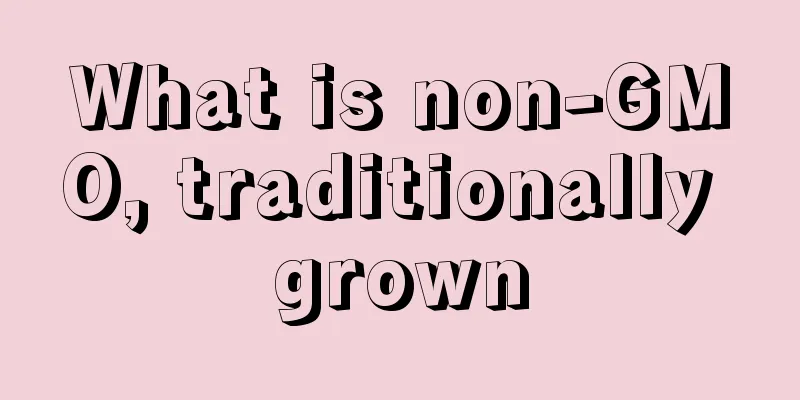What is non-GMO, traditionally grown

|
In the past, everything we ate was non-GMO, and was the healthiest and safest. But now our lives are about to be replaced by GMOs. Although GMO foods have advantages in some aspects, they can never be compared with non-GMO foods. 1. What is non-GMO It is not something that is genetically modified. To understand this question, we must first understand what genetically modified organisms are. Genetically modified organisms mean that scientists change the genes of animals and plants in laboratories and then create food types with new characteristics. For example, by adding an antifreeze gene from marine fish grown in the Arctic to ordinary tomatoes, this popular food can be preserved longer in the winter, greatly extending its shelf life. The topic of genetically modified foods quickly split into two camps. Those who support it believe that technological advances can greatly improve our living standards, while those who oppose it believe that genetically modified foods can cause unexpected poisoning or allergic reactions. 2. Genetically modified organisms 1. Artificial genetic modification Introducing artificially isolated and modified genes into the genome of an organism, The expression of the introduced gene causes the heritable modification of the characteristics of the organism. This technology is called transgenic technology. technology). The terms "genetic engineering", "genetic engineering" and "genetic transformation" that people often talk about are all synonyms for genetic modification. Nowadays, artificial technology for changing the traits of animals and plants is often called genetic modification technology (in a narrow sense), while the manipulation of microorganisms is generally called genetic engineering technology (in a narrow sense). Organisms modified by genetic engineering technology are often referred to as "genetically modified organisms" (GMOs) in the media. 2. Natural genetic modification It is not artificially directed, but a transgenic phenomenon that occurs autonomously in animals, plants or microorganisms in nature, such as lentiviral vectors The hepatitis B virus DNA is integrated into the chromosomes of human sperm cells, the bacteriophage inserts its own DNA into the lysogenic cell DNA, Agrobacterium and cauliflower mosaic virus (CMV), etc. 3. Plant genetic modification Transgenic plants are plants that contain foreign genes in their genome. It can be obtained through protoplast fusion, cell recombination, genetic material transfer, chromosome engineering technology, and may change certain genetic characteristics of plants to cultivate new crop varieties that are high-yield, high-quality, virus-resistant, insect-resistant, cold-resistant, drought-resistant, flood-resistant, salt-alkali-resistant, and herbicide-resistant, such as corn and rice. , Arctic avocado, and genetically modified triploid poplar. Moreover, transgenic plants or in vitro cultured cells can be used to produce expression products of exogenous genes. For example, genes such as human growth hormone, insulin, interferon, interleukin 2, epidermal growth factor, and hepatitis B vaccine have been expressed in transgenic plants. |
<<: What to do if you have toothache? These methods will teach you
Recommend
What foods are good for intrahepatic bile duct stones
Patients with intrahepatic bile duct stones need ...
What to do if you burp after chewing gum
In modern society, many people choose to chew gum...
What are the causes of numbness in the back of the head?
Numbness at the back of the head is not a disease...
What are the classifications of lung cancer? How to clearly diagnose the classification of lung cancer?
Lung cancer is a malignant tumor of the respirato...
What kind of honey is good for getting angry
Ordinary sugars such as white sugar and rock suga...
How to make various drinks?
In the hot summer, drinks are the most popular th...
What are the effects and functions of lavender essential oil?
Lavender, as a flower plant, appears very frequen...
There is such a big difference between alcohol allergy and urticaria
Some people will experience allergic reactions af...
What are the reasons for foam in urine
There is foam in a lot of urine, so it makes peop...
How is prostate cancer caused? 4 causes of prostate cancer that should be avoided
The occurrence of prostate cancer can bring great...
How to gain weight if you are thin
In our lives, there is always a type of people th...
Chinese and Western medicine can achieve very good results in treating rectal cancer
Although rectal cancer occurs frequently nowadays...
The efficacy of pine and cypress leaves for washing hair
Pine and cypress leaves also have a certain effec...
Can minimally invasive surgery eliminate the worry of rhinitis?
Allergic rhinitis, which is commonly known as all...
What should I take when visiting a woman who has just given birth?
A parturient is a woman who has just gone through...









